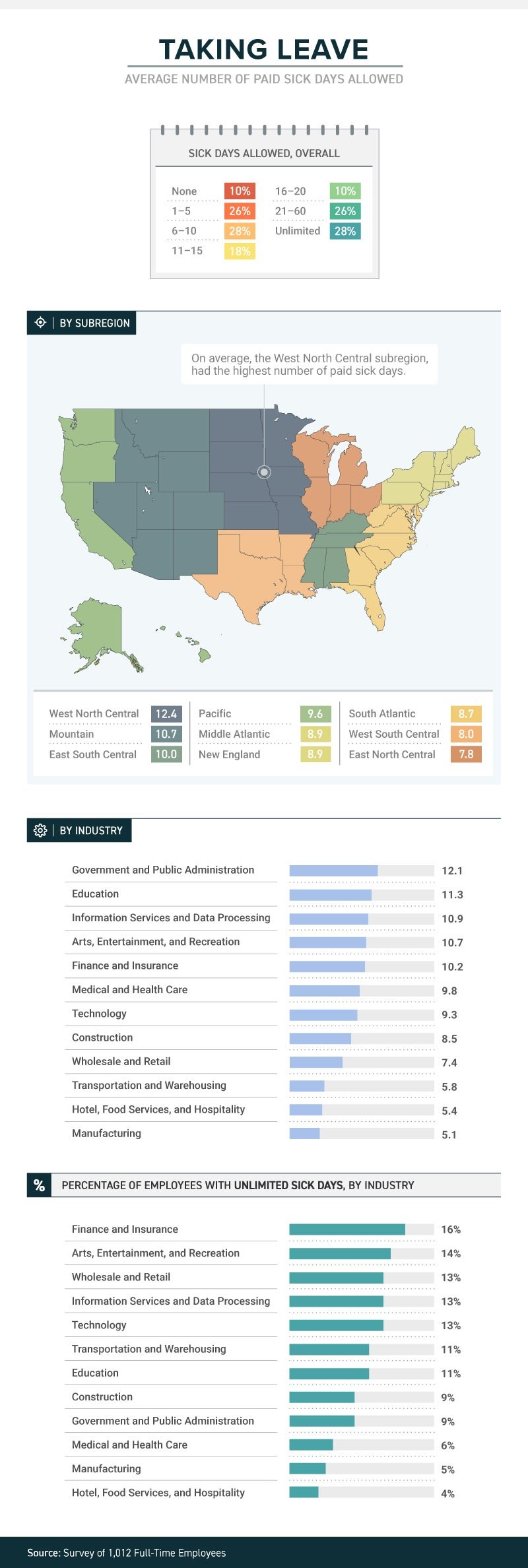Are Your Workers Sleeping on the Job?
A recent survey by Accountemps revealed that approximately three-quarters of American adults surveyed reported feeling tired at work often. Consistent tiredness can be a big risk for companies even if employees aren’t actually falling asleep on the job. Continue reading to learn more.
The occasional Monday-morning yawn is a common sight at most offices—but, according to new research, a staggering number of employees report being tired at work. Even if workers aren’t actually sleeping on the job, consistent tiredness could spell big trouble for productivity and retention.
Staffing firm Accountemps surveyed 2,800 American adults working in office environments, finding that nearly three-quarters report being tired at work often (specifically, 31 percent said very often, and 43 perfect reported feeling tired somewhat often). Twenty-four percent said it’s not very often that they’re yawning on the job, while just 2 percent said they never feel tired at work.
The report also ranked the top 15 “sleepiest” cities based on survey responses, with Nashville, Tenn. claiming the No. 1 spot, followed by a three-way tie between Denver, Indianapolis and Austin, Texas.
Michael Steinitz, executive director of Accountemps, noted that on-the-job errors would naturally follow if you have a workforce of tired employees. And, he says, “Consider the underlying causes of why employees are sleepy: If it’s because they’re stretched too thin, retention issues could soon follow.”
Those ideas are bolstered by research from Hult International Business School, which found that the 1,000 workers in its study average about 6.5 hours of sleep per night, lower than the seven to eight hours recommended by the American Academy of Sleep Medicine. Even a half-hour less than the optimal sleep time, researchers found, led to poorer workplace performance. Tired workers reported a lack of focus, needing more time to complete tasks, struggling with creativity, lacking motivation to learn and challenges to multitasking. Many of those side effects of being tired at work, the researchers wrote, are often mistakenly attributed to poor training or work culture when, in reality, they may stem from sleeplessness.
Lack of sleep has a well-documented impact on physical health, and Hult also noted its effects on mental wellness. A vast majority of respondents (84 percent) said they feel irritable at work when they’re tired, and more than half reported feelings of frustration and stress—all of which, researchers noted, can impact teamwork and collaboration.
Accountemps suggested a number of ways employees can guard against being tired at work: physical exercise, being more communicative with managers and leaving work at the office, such as by not bringing a phone or laptop to bed to decrease the chances of letting work communications keep them up at night. On the employer side, the firm recommended managers set reasonable office hours, increase face-to-face meetings with subordinates to see where support is needed and encourage workers to unplug when they leave the office.
SOURCE: Colletta, J. (26 October 2018) "Are Your Workers Sleeping on the Job?" (Web Blog Post). Retrieved from https://hrexecutive.com/are-your-workers-sleeping-on-the-job/
Healthcare waste is costing billions — and employers aren’t doing anything about it
Providing your employees with healthcare insurance is expensive. A large chunk of healthcare costs is being wasted by the healthcare industry, according to a new survey. Read on to learn more.
Providing the workforce with healthcare coverage is expensive, but a new survey of 126 employers suggests a large chunk of that cost is being wasted by the healthcare industry on treatments patients don’t need.
The healthcare industry wastes $750 billion per year on unnecessary tests and treatments, according to a survey from the National Alliance of Healthcare Purchaser Coalitions and Benfield, a market research, strategy and communications consulting firm. Some 60% of employers don’t take steps to manage their healthcare plan’s wasteful spending, despite the fact that the same percentage of employers view it as a problem, the survey says.
“While waste has long been identified as a key concern and cost contributor, employers are operating blind and need to look at a more disciplined approach to address top drivers that influence waste,” says Michael Thompson, National Alliance president and CEO.

Employers are under the impression that prescription drugs are the culprit behind the spending waste, and they are, just not as much as other services. Around 54% of health spending waste is caused by unnecessary medical imaging tests, such as MRIs and X-rays, the survey says. Specialty drugs, unnecessary lab tests and specialists referrals are also major money pits.
However, the survey data isn’t suggesting these procedures and treatments shouldn’t be covered by employer health plans. The tests and treatments are potentially life-saving, they’re just used more than they should be. Sometimes previous test results can help with a current diagnosis, but medical staff don’t always check patient files before ordering new tests.
Most employers don’t monitor unnecessary healthcare spending. The 34% of employers who do rely entirely on their healthcare vendors to do it for them, trusting that it’s being taken care of.
“The idea of reducing waste in the healthcare system can be overwhelming,” says Laura Rudder Huff, senior consultant for Benfield. “While employers ask themselves: ‘Where to start?’ this is an issue where even small steps matter. Employers can begin by collecting data to identify where the inefficiencies are in their workforce and community and use assets such as vendors and organizations like coalitions to realize market improvements.”
The survey also recommends employers enlist the services of Choosing Wisely, an organization that counsels patients and employers on healthcare plans and medical treatments.
This article originally appeared in Employee Benefit Adviser.
SOURCE: Webster, K. (7 November 2018) "Healthcare waste is costing billions — and employers aren’t doing anything about it" (Web Blog Post). Retrieved from https://www.benefitnews.com/news/healthcare-waste-is-costing-billions-and-employers-arent-doing-anything-about-it
Addressing Long-Term Care Concerns
When insurance plan conversations lead to discussions about after retirement, there are certain hot-button issues that will swing employee conversations out of your control. When helping older employees with retirement and beyond, two topics will change the atmosphere in the room. One is the long-term viability of Social Security, which frequently comes up as a question. The second is on the conversation of long-term care, which has the possibility to make or break a retirement plan. In this installment of CenterStage, Donald McClurg, one of our financial advisors, breaks down what matters and offers answers to many of the questions concerning long-term health.

What Exactly is Long-Term Care? What’s Gobbling up Your Retirement?
You place insurance on the things that are valuable to you, such as your car, your home and possibly your pet. What about your life? Is your family of importance to you, and beyond that, what about your legacy (i.e. any funds left over from your lifetime given into your living family members)? Currently, there’s about a 50% chance a 65-year-old will require care such as an in-home nurse or a medical/assisted living facility that can deliver optimal, specialized care. For employees near retirement or the 65 years-old mark, there is a trove of questions surrounding long-term care, including:
- Should I consider a hybrid long-term care plan?
- Is the insurance worth it for me, given how insurers have been increasing the price of premiums?
- How do I avoid a government facility should I need care?
- How much money should be saved and when should saving begin?
- Can I afford this/Will I make it?
- What are my blind spots?
Unfortunately, the “right” answer to these vexing questions regarding long-term healthcare is exclusively individual-specific. Factors in the determination are dependent upon the individual’s wealth, age, desire to leave a bequest and a need for peace of mind, amongst all other factors. Donald believes, “The biggest risk to a financial plan is not running out of money, it is incurring a financial catastrophe later in life and not having protection. Right now, that catastrophe has the highest probability of showing up in the form of long-term care.”
Commonly viewed as less superior to other insurance options already being taken out of a paycheck, the fact of the matter is this is not another out-of-pocket expense placed on you, such as renters or car insurance. Rather, long-term care should be seen as a valuable choice; an investment in your future and for your family. As a “numbers guy”, Donald brings up the importance of three variables in particular: 70, 90, and 5, which mean:
- Singles 65 and older stand a 70% chance of needing long-term coverage
- Couples 65 and older stand a 90% chance of needing long-term care
- Only 5% of Americans have long-term coverage plans
The Driving Factor for Long-Term Care
Individuals display an adversity to paying for long-term coverage, as they are worried about the chance of paying for it and not needing it or having to leave their homes and live out their lives in a facility. If that’s you, you may consider a hybrid plan. Most hybrids solve the two main deterrents of long-term care insurance by:
- Allowing for in-home care (that’s right, they don’t force you into a facility)
- Return of unused premiums. (i.e. whatever portion you don’t use is returned to your beneficiary)
According to the U.S. Department of Health and Human Services, the average cost for a semi-private room in a nursing home is $6,844 per month, with the average stay being around 2.5 years. As previously listed, 52.3% is the expected percentage of people turning 65 who will have to have a long-term care need during their lives. That is over half the population of individuals turning 65 years of age who will need the assistance offered through long-term care.
The most misleading stat is that 63% of people spend $0 on long-term care. This is because roughly half of Americans have exactly $0 in savings or will have $0 when/if they need long-term care. Those individuals typically find themselves at facilities who accept Medicaid, meaning they are more than likely falling short of the care they need. Here’s the most under reported and most impactful fact of long-term care: the burden is falling on your employees. In total, an estimated $3 trillion in lifetime wages is lost due to unpaid care-giving responsibilities.
How Can Employers Offer Better Long-Term Care Solutions?
It has been said that happy employees are productive employees, and as an employer, you naturally want to increase both the productivity and well-being of employees. Of the many things your employees stress about (home, kids, work, etc.), money is always at the top of the list. In fact, a study investigating employee productivity and well-being found that employees spend 3-4 hours per week, 4-5 times per hour worried about finances. At Saxon, we are happy to help employers implement useful financial tools for their employees to leverage.
For the majority of the working world, healthcare derives from employers, thus, the head of the organization is the one responsible for properly educating employees on their coverage. As the saying goes, “proper planning prevents poor procedure.” With Saxon, employers can schedule a brief, in-house seminar with one of our stellar financial advisors and a long-term care specialist. Through these seminars, clients and employees will discover clear solutions to anything that may still have them on the fence about investing in long-term health. Employees will come to learn the real value in long-term care, such as the reason behind asset location mattering more than asset allocation.
Ready to explore your options and become one of the 0.5% of businesses currently offering long-term care insurance to their employees? If so, don’t hesitate; pick up the phone and call Donald with Saxon Financial today at (513) 609-4404 or toll-free at (800) 847-1733 to discover how you can avoid the single largest threat to your employees’ retirement.
Why Saxon Is the Right Choice for You
At Saxon, we care about you – your family, your company, your finances, and your future. We cultivate our years of practice and experience to deliver exceptional service to you every time. We empower you by placing the tools and knowledge necessary into your hands to deliver remarkable returns on investment. An engagement with Saxon is unique. This is because we have invested in developing a culture where business is personal. Our clients are the central heart of our organization; meaning that without you we have no purpose.
To Saxon, experience matters. We know that outcome is crucial, but to us, it matters how we get there. By taking intentional action in an authentic manner, we are a catalyst for your success that is positively refreshing. We invite you to explore the Saxon way.
HR’s recurring headache: Convincing employees to get a flu shot
According to The National Institute for Occupational Safety and Health, the flu cost U.S. companies billions of dollars in medical fees and lost earnings. Read this blog post to learn how HR departments are convincing their employees to get a flu shot.
Elizabeth Frenzel and her team are the Ford assembly line of flu shots: They can administer about 1,800 flu shots in four hours.
Frenzel is the director of employee health and wellbeing at the University of Texas MD Anderson Cancer Center, and with 20,000 employees, she is no stranger to spearheading large flu shot programs. The center where Frenzel administers flu shots has roughly a 96% employee vaccination rate. Back in 2006, only about 56% of employees got their shots.
“When you run these large clinics, safety is critically important,” she says.
Problems like Frenzel’s are not unique. Every fall, HR departments send mass emails encouraging employees to get vaccinated. The flu affects workforces across the country, costing U.S. companies billions of dollars in medical fees and lost earnings, according toThe National Institute for Occupational Safety and Health. It is not only a cause of absenteeism but a sick employee can put their coworkers at risk. Last year the flu killed roughly 80,000 people, according to the Centers for Disease Control.
Even if an employer offers a flu shot benefit, the push to get employees to sign up for the vaccine can be a two-month slough, with reminder emails going unanswered. Moreover, companies often contend with misconceptions about the shot, such as the popular fallacy that shots will make you sick, running out of the vaccine, and sometimes just plain employee laziness.
In Frenzel’s case, increasing the number of employees who got flu shots weren’t just a good idea, but it was needed to protect the lives of the cancer patients they interact with every day. The most startling fact, she says, was that healthcare workers who interact with patients daily were less likely to get vaccinated.
“So that’s how we started down the path,” she says. “Really targeting these people who had the closest patient contact.”
Frenzel credits the significant increase in employee participation in the flu shot program to several factors. They made the program mandatory — a common move in the healthcare industry — but Frenzel says their improvement also was related to flu shot education. The center made it a priority to explain to staff members exactly why they should get vaccinated. Frenzel made it more convenient, offering the vaccine at different hours of the day, so all employees could fit it into their schedule. They also made it fun, offering stickers for employees to put on their badge once they got a shot. Every year, she says, they pick a new color.
Employers outside of the medical industry are focused on improving their flu shot programs, including Edward Yost, manager of employee relations and development at the Society for Human Resource Management, who helped organize a health fair and flu shot program for 380 employees.
Yost says onsite flu shot programs are more effective than vouchers that allow employees to get vaccinated at a primary care doctor or pharmacy. The more convenient you make the program, he says, the more likely employees will use it.
“There’s no guarantee that those vouchers are going to be used,” he says. “Most people aren’t running out to a Walgreens or a CVS saying, please stab me in the arm.”
Besides the convenience, employees are more likely to sign up for a shot when they see co-workers getting vaccinated, Yost says. If a company decides to offer an onsite program, planning ahead is key. Sometimes employees will not sign up in advance for the vaccine but then decide they want to get one once the vendor arrives onsite. Yost recommends companies order extra vaccines.
“Make sure that you’re building in the expectation that there's going to be at least a handful of folks who are more or less what you call walk-ins in that circumstance,” he says.
Incentivizing employees to get the flu shot is also important, Yost says. Some firms will offer a gym membership or discounted medical premiums if they attend regular checkups and get a biometric screening in addition to a flu shot. He recommends explaining to employees how a vaccine can help reduce the number of sick days they may use.
“Employees need to see that there’s something in it for them,” Yost says. “And quite honestly, being sick is a miserable thing to experience.”
Affiliated Physicians is one of the vendors that can come in and administer flu shots in the office. The company has provided various employers with vaccines for more than 30 years, including SourceMedia, the parent company of Employee Benefit News andEmployee Benefit Adviser. In the past 15 years, Ari Cukier, chief operating officer of the company, says there’s been an increase in the amount of smaller companies signing up for onsite vaccines. HR executives should be aware of the number of employees signing up for vaccinations when scheduling an onsite visit.
“We can’t go onsite for five shots, but 20-25 shots and up, we’ll go,” Cukier says.
Cukier agrees communication between human resources departments and employees is crucial in getting people to sign up for shots. Over the years, he’s noticed that more people tend to sign up for shots based on the severity of the previous flu season.
“Last year, as bad as it was, we have seen a higher participation this year,” he says.
Brett Perkison, assistant professor of occupational medicine at the University of Texas School of Public Health in Houston, says providing a good flu shot program starts from the top down. The company executives, including the CEO and HR executives, should set an example by getting and promoting the shots themselves, he says.
It’s also important to listen to employee concerns. Before implementing a program, if workers are taking issue with the shot, it’s best to hold focus groups to alleviate any worries before the shots are even being administered, he says.
Some employees may even believe misconceptions like the flu shot will make one sick or lead to long-term illnesses, he says. Others may question the effectiveness of the shot. Having open lines of communication with employees to address these concerns will ensure that more will sign up, Perkison says.
Regardless of the type of flu shot program, the most important part is preventing illness, SHRM’s Yost says. While missing work and losing money are important consequences of a flu outbreak, having long-term health issues is even more serious, he says. Plus, no one likes being sick.
“Who’s going to argue about that?” he says.
This article originally appeared in Employee Benefit News.
SOURCE: Hroncich, C (24 October 2018) "HR’s recurring headache: Convincing employees to get a flu shot" (Web Blog Post). Retrieved from https://www.employeebenefitadviser.com/news/hrs-recurring-headache-convincing-employees-to-get-a-flu-shot
Ready for the sounds of office sniffles?
A recent study by law firm, Farah and Farah, states that one in four full-time workers receive between 1 and 5 sick days. Continue reading to learn more.
It’s not just a matter of whether they feel well enough to work, or whether they have sick days. The boss’s attitude about whether workers should take sick days or not can determine whether they actually do stay home when they’re sick, or instead come to work to spread their germs to all and sundry.
A new study from law firm Farah & Farah finds that even though it can take a person some 10 days to fully recover from a cold, approximately 10 percent of full-time workers in the U.S. get no sick days at all (part-timers don’t usually get them either), while more than 1 in 4 have to make do with between 1 and 5 sick days. Just 18 percent get enough sick time to actually recover from that cold—between 11 and 15 days.
The amount (or presence) of sick time varies from industry to industry, with government and public administration providing the most (an average of 12.1) and both hotel, food services and hospitality and manufacturing providing the least (an average of 5.4 for the hospitality industry and 5.1 for manufacturing). Some lucky souls actually get unlimited sick days, although even then they don’t always use them.
Regardless of industry, or quantity, just because workers get sick days it doesn’t mean they use them. Workers often worry that they’ll be discouraged from using them, with employers who may provide them but not encourage employees to stay home when ill. In fact, 38 percent of workers show up to work whether they’re contagious or not. Sadly for the people they encounter at work, the most likely to do so are in hospitality, medical and healthcare and transportation. Plenty of germ-spreading to be done in those professions!
And their employers’ attitudes play a role in how satisfied they are with their jobs. Among those who work for the 34 percent of bosses who encourage sick employees to stay home, 43 percent said they’re satisfied with their jobs in general. Among those who work for the 47 percent of bosses who are neutral about the use of sick days, that drops to 21 percent—and among the unfortunate workers who work for the 19 percent of bosses who actually discourage workers from staying home while ill, just 12 percent were satisfied with their jobs.
When it comes to mental health days (no, not that kind; the ones people really need to deal with diagnosed mental health conditions), fewer than 1 in 10 men and women were willing to call in sick. Taking “mental health days” when physically healthy, however, either to play hooky or simply have a vacation from the office, is something that 15 percent of respondents admitted to.
SOURCE: Satter, M (5 October 2018) "Ready for the sounds of office sniffles?" (Web Blog Post). Retrieved from https://www.benefitspro.com/2018/10/05/ready-for-the-sounds-of-office-sniffles/
Original report retrieved from https://farahandfarah.com/studies/sick-days-in-america
How employers can support employees during cancer treatment
Many people with cancer are choosing to continue working during their treatment. Read this blog post to learn how employers can support their employees during their cancer treatment.
Thanks to more sensitive diagnostic testing, earlier diagnosis and new treatments, the number of cancer survivors in the U.S. has grown to 15.5 million, and that number is projected to increase to 20.3 million by 2026. In addition, about 1.7 million Americans are projected to be diagnosed with cancer this year. A large percentage of these cancer patients and survivors are still active members of the workforce and the numbers have the potential to increase even more as people remain in the workforce beyond age 65.
Some people with cancer choose to continue working during treatment. Reasons for continuing to work can be psychological as well as financial. For some, their job or career is a big part of the foundation of their identity. A survey conducted by the non-profit Cancer and Careers found that 48% of those surveyed said they continued to work during treatment because they wanted to keep their lives as normal as possible, and 38% said they worked so that they felt productive. Being in the workforce also provides a connection to a supportive social system for many people and boosts their self-esteem and quality of life.
See also:
There also are financial benefits to the employer when employees continue to work during cancer treatment. Turnover costs, including hiring temporary employees and training replacement employees, are high. The cost of turnover for employees who earn $50,000 per year or less (which is approximately 75% of U.S. workers) average 20% of salary. For senior and executive level employees, that cost can reach 213% of salary. In addition, it can be costly to lose the experience, expertise, contacts and customer relationships employees have built.
This raises the question for employers: How can I support employees who choose to work while undergoing cancer treatment? Providing that support can be complex as employers work to balance their legal responsibilities under the Americans with Disabilities and Family and Medical Leave Acts with the privacy requirements of the Health Insurance Portability and Accountability Act (HIPAA).
When an employee chooses to share his or her diagnosis with a supervisor or HR representative, employers should view this disclosure as the beginning of a conversation with the employee taking the lead. (It’s up to the employee what information he or she wants to disclose about the diagnosis and treatment and with whom the information can be shared within the organization.) Here are four ways employers can support employees who are getting cancer treatment.
Help employees understand what benefits are available
The first step an employer should take is to refer the employee to the organization’s human resources manager (or someone who handles HR matters if the organization is smaller and does not have a human resources department) so that person can share information about all available benefits and pertinent policies. Provide details on:
- Medical and prescription drug coverages, including deductibles, co-pays, precertification requirements, network healthcare providers and plan and lifetime maximums
- Leave policies
- Flexible scheduling and remote work options, if available
- Employee assistance programs
- Community resources and support groups
See also:
Offer professional guidance
Offering patient navigator or case management services can also be beneficial. Navigators and case managers can provide a range of services including:
- Connecting employees with healthcare providers
- Arranging second opinions
- Providing evidence-based information on the type of cancer the employee has been diagnosed with and options for treatments
- Help filing health insurance claims, reviewing medical bills and handling medical paperwork
- Coordinating communication and medical records among members of the treatment team
- Attending appointments with employees
- Answering employee questions about treatments and managing side effects
Make accommodations
Workplace accommodations are another key pillar of support for employees working during cancer treatment. In addition to flexible scheduling, to accommodate medical appointments and help employees manage side effects like fatigue and nausea, and the option of working from home, workplace accommodations can include:
- Temporary assignment to a less physically taxing job
- Substituting video conferencing or online meetings for travel, which can be difficult for employees dealing with fatigue or a suppressed immune system, and can make it hard to attend needed medical appointments
- Leave sharing for employees who have used all their paid time off and can’t afford to take unpaid leave. Some organizations offer leave banks or pools where employees can “deposit” or donate some of their vacation days for employees dealing with a serious illness to use.
See also:
Employees may continue to need accommodations after treatment ends if they face late side effects such as fatigue, difficulty concentrating, numbness caused by nerve damage or heart or lung problems. Continuing job and schedule modifications can help mitigate the situation.
Ask for employee input
An often overlooked part of supporting employees who are working during cancer treatment is asking the employee what types of support he or she needs and prefers. Employees can share any medical restrictions related to their condition, what types of accommodations or equipment will help them do their job, and what schedule changes will allow them to attend needed appointments and recover from treatment. This should be an ongoing conversation because the employee’s needs are likely to change over the course of treatment and recovery.
SOURCE: Varn, M. (21 September 2018) "How employers can support employees during cancer treatment" (Web Blog Post). Retrieved from https://www.benefitnews.com/opinion/how-employers-can-support-employees-during-cancer-treatment?brief=00000152-14a5-d1cc-a5fa-7cff48fe0001
The days of employers ignoring the opioid crisis are over
What do employers need to know to help their employees and help reduce the risk of the opioid crisis? The opioid crisis is affecting companies' productivity, medical claims, work injuries and their bottom line. Read this blog post to learn more.
Productivity, medical claims, work injuries, and the company’s bottom line — what do these things all have in common? They are all being drastically affected by the effects of substance abuse. The opioid crisis that is running rampant across the United States is having an impact on employees at every level.
As an employer, what do you need to know to support your employees and reduce the risk of this national crisis?
First, you need to educate yourself on the facts. According to the National Institute on Drug Abuse, every day, more than 115 people in the U.S. die after overdosing on opioids. It is not just the deadly heroin/fentanyl combination that we have been hearing about in the news, sources of opioid addiction include prescription pain relievers such as hydrocodone, oxycodone, oxymorphone, morphine, codeine, and other prescribed substances.
See also: Taking A Page From Pharma’s Playbook To Fight The Opioid Crisis
The Center for Disease Control and Prevention estimates prescription opioid misuse in the U.S. cost $78.5 billion per year; affecting medical spend, productivity, and law enforcement supervision.
Substance abuse does not discriminate on any demographic, however if your business is construction, entertainment, recreation, or food service, the National Safety Council found your employees are twice as likelyas the national average to have substance abuse disorders.

Secondly, you need to take action. The most important thing an employer can do is to have a proactive plan in place to help your employees live a healthy lifestyle. It is easy to get in the habit of saying “that does not happen here,” but the reality is substance abuse can — and does — happen anywhere.
Solving the opioid crisis won’t happen overnight, but here are some steps to take to build a better relationship with your employees and quite possibly help someone overcome a substance abuse problem.
Train your staff. Explain what resources are available to help them help your employees. If you have an employee assistance program in place, leverage it, and have the information easily available so any employee can access the information at any time. This will help lower the fear barrier for employees who are not ready to ask someone they know for help. If you do not have the right resources in place today there are many programs available, and it is important that you adopt one that will fit your culture and help employees be high performers.
See also: Employers take steps to address opioid crisis
Show employees you care. Look for signs and symptoms that an employee might have a problem with substance abuse. Make sure supervisors, managers, and team leaders are aware of these signs and what actions they should take. Have an open door policy, and make sure your employees feel they can ask for assistance when they need it. It is important to know how to handle sensitive, often painful, discussions in a professional and action-oriented manner. It is essential that you have the right steps in place to ensure leadership is aligned with the organization’s strategy on how best to help your at-risk population.
Be transparent. Have clear policies in place that promote a drug-free workplace. Consider expanding your drug testing panel to include opioids.
Share the savings. Consider sharing the dollars a successful well-being program will save your organization’s bottom line through lower prescription drug costs and less lost productivity due to illness and time away from work.
See also: A look at how the opioid crisis has affected people with employer coverage
If your organization is struggling with how to successfully address the challenges of substance abuse and opioid addiction, seek out employee benefit consultants to help you develop a strategy for success. Like anyone with an addiction, there is no shame in asking for help.
SOURCE: Panning, C (7 September 2018) "The days of employers ignoring the opioid crisis are over" (Web Blog Post). Retrieved from https://www.benefitnews.com/opinion/employers-cannot-ignoring-the-opioid-crisis?feed=00000152-a2fb-d118-ab57-b3ff6e310000
5 steps to improving employees’ mental health
Do your employees have an “always on” mentality? Many employees are making themselves available 24/7, costing businesses big time due to workplace stress. Read this blog post to learn more.
Technology has transformed the way many of us work, but it also has almost completely eliminated our ability to unplug, de-stress and take care of our mental health. Many employees make themselves available 24/7, checking email before they go to sleep and as soon as they wake up. This “always on” mentality is costing everyone — businesses spend $300 billion each year on absenteeism, diminished productivity, employee turnover and insurance fees due to workplace stress.
Stress and mental health are increasingly important issues in the office. Elevated stress levels lead to mistakes, lower productivity, lower employee morale, higher rates of absenteeism and even physical illnesses such as high blood pressure and heart disease.
Up to 14% of mental health issues could be completely avoided by reducing workplace stress, according to the National Institutes of Mental Health. Now, more than ever, employers need to make sure their employees have the right resources to help combat depression, anxiety, stress and job strain.
Here are five ways employers can improve employees’ mental health.
Remove the stigma. Improving the mental health of your employees starts with talking openly about it. Employers should focus on mental health as part of a wider wellbeing program — calling attention to the need to relieve stress and seek help for mental health problems.
Workplace training to help employees and managers recognize the signs of stress and poor mental health can also bring attention to the issue.
Provide and promote stress-relief activities. Employers can build in activities to help relieve stress during the workday. Yoga, exercise classes and walking groups can help employees cash in on the feel-good endorphins that come from physical activity.
Some larger companies take stress relief to the next level. Office gyms, weight rooms and boxing gyms provide stress relief outlets. Some companies even employ in-house psychologists and other professionals to help teach employees how to manage their stress and fears.
Consider a flexible work policy. On a more basic level, creating a more flexible work policy throughout the day can also help. Everyone needs to take care of personal business from time to time, whether it’s a doctor’s appointment or a home maintenance issue. Take advantage of technology and allowing your employees to work from home or change their hours can help reduce stress.
Develop a financial wellness program. Financial fears are stressing out your employees. More than half of workers say they are stressed about money, and the younger the worker, the more likely he or she is to be worried. Creating a financial wellness program that educates employees on how to better manage their money can help remove this stress. A program could include helping younger generations balance paying back student debt with budgeting and saving, while older generations may focus on putting their kids through college while saving for retirement. Other topics to cover include making big purchases, such as a home or a car.
Highlight your employee assistance program. Draw attention to benefits that can help people cope with mental health issues. You very likely already offer an EAP, but you may not stress enough how it can help employees who may need assistance. Generally, an EAP includes telephone-based or in-person counseling, referrals and other resources to help assess and treat mental health issues. Communicate the details of your company’s EAP often (not just during open enrollment) to give employers another way to improve their wellbeing.
Your employees are your greatest asset; ensuring they are healthy is in your best interest. Facing mental wellbeing head-on can help you keep your employees happy and healthy, and help you boost your business.
SOURCE: Newman, H (25 June 2018) "5 steps to improving employees’ mental health" (Web Blog Post). Retrieved from https://www.employeebenefitadviser.com/opinion/improving-mental-health-in-the-workplace?tag=00000151-16d0-def7-a1db-97f03ad90000
10 creative ways to help working parents
The parenting workforce is changing. Most working parents are concerned they won’t have enough time for their children. Continue reading to learn how employers can help working parents.
Can working moms have it all? Say goodbye to the broad-shouldered power suits of the ’80s and ’90s. Juggling a career and raising children is no longer a women’s-only issue.
While mothers are now the primary or sole source of income for 40% of American households with children, 75% of employees of all genders report their biggest concern as a working parent is not having enough time for their children. From single dads to same-sex couples, breadwinning moms to full-time working grandparents, the parenting workforce is changing.
No matter a family’s parenting makeup, employers can take an active role to help alleviate daily stressors affecting all working parents in the new, high-demand workplace. Here are 10 ways to do so.
1. Get real about childcare.
2. Offer flexibility.
3. Make it convenient.
4. Help tackle the “hate-to-do” list.
5. Promote total health.
6. Prioritize mental wellness.
7. Remember the older kids.
8. Simplify travel.
9. Don’t forget the “working” in working parents.
10. Stay inclusive.
Remember that caregiving responsibilities can encompass a wide range of family situations. Make sure programs and policies — as well as communications about them — support fathers, single parents, adoptive and foster parents, same-sex couples and grandparent-caregivers.
Being a parent is a rewarding and enriching experience — but it can also be exhausting and thankless, especially for those juggling work and family. Fortunately, it doesn’t take much to make the workplace a more supportive, less stressful place for working parents, who will likely return the favor with greater productivity, engagement and loyalty.
3 ways to promote inclusion in your workplace
Are you looking to grow your current inclusion practices or build new ones? Read this blog post to learn three ways employers can promote inclusion in their workplace.
Diversity and inclusion is top of mind for HR practitioners and employees alike. If we think about diversity as who is walking through the door, then inclusion would be the next part of the employee experience. With the recent focus on workplace diversity trends, it’s important to not forget how important it is to create an inclusive working environment.
It’s critical to facilitate relationship building with new hires and their teams. We often focus on the work to be done without taking time to get to know our co-workers as individuals. When we see each other as people and learn to appreciate our similarities and differences, it makes it easier for everyone to thrive.
Whether you’re looking to grow your current inclusion practices or are starting from scratch, try these three action items:
1. Don’t be afraid to ask.
It may sound simple, but a great first step to improving inclusion is to survey employees. By conducting quick and easy “pulse” surveys, you can gauge the level of belonging that employees feel. You can do this by launching survey focused on diversity or add questions around inclusion and belonging into your existing employee engagement surveys. Once you have a baseline on company sentiment, you can begin to improve areas that may be lacking. Start to put in place mechanisms to support individuals from different backgrounds and don’t forget to conduct these surveys on an ongoing basis.
2. New Hire Buddies
Whether you’re an introvert, extrovert, or somewhere in between, it can be hard to meet new people when you start a new job. Consider creating a “buddy” program to encourage new hires to bond with their co-workers. Companies hit roadblocks when they put the onus on new employees to reach out and engage with their teams. Having the support of a “buddy” at work helps create a feeling of security, which leads to greater engagement. The more engaged your employees are, the longer they will want to stay with your company.
3. Resource Groups
Employee resource groups (ERGs), sometimes also called affinity groups, serve as a platform that employees can use to build a culture of inclusion and belonging. Not only do they foster a sense of community within your organization, they also help new hires transition into their new working environment. These groups create opportunities for education and understanding between diverse individuals across your company. They can also be a great launchpad for new ideas and change in creating more inclusive policies and practices.
Fostering an inclusive company culture helps increase both engagement and retention. The better an employee feels about working at your organization, the greater the likelihood that they will reach their full potential on the job. Measure your current state of inclusion with regular pulse surveys and follow up with making changes as necessary to foster stronger relationships across the organization.
Source: Li, J. (19 July 2018). "3 ways to promote inclusion in your workplace" (Web Blog Post). Retrieved from https://blog.shrm.org/blog/3-ways-to-promote-inclusion-in-your-workplace










